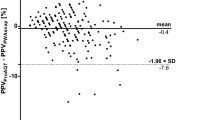Abstract
Pulse pressure variation (PPV) can be monitored several ways, but according to recent survey data it is most often visually estimated (“eyeballed”) by practitioners. It is not known how accurate visual estimation of PPV is, or whether eyeballing of PPV in goal-directed fluid therapy studies may limit the ability to blind the control group to PPV value. The goal of this study was to test the accuracy of visual estimation of PPV. Using a simulator program designed by the authors that runs on a PC, 20 residents and 19 attendings were shown five arterial pressure waveforms each with different PPV values (range 1–30 %) moving at one of three sweep speeds (6.25, 12.5, or 25 mm/s) and asked to determine the PPV. There was a weak but significant relationship between true PPV and eyeball PPV (r 2 = 0.22; p < 0.01). The agreement between true PPV and eyeball PPV was 3.3 ± 8.7 %. The mean percent error was 122 %. The rate of correct response group classification was 65 %. Mean percent error was higher the faster the waveform sweep speed (130 % at 25 mm/s vs. 117 % at 6.25 mm/s), and correct responsiveness classification lower (58 % at 25 mm/s vs. 69 % at 6.25 mm/s). The results from this study show that eyeballing the arterial pressure waveform in order to evaluate pulse pressure variation is not accurate.





Similar content being viewed by others
References
Cannesson M, Le Manach Y, Hofer CK, Goarin JP, Lehot JJ, Vallet B, Tavernier B. Assessing the diagnostic accuracy of pulse pressure variations for the prediction of fluid responsiveness: a “Gray Zone” approach. Anesthesiology. 2011;115:896–7.
Marik PE, Cavallazzi R, Vasu T, Hirani A. Dynamic changes in arterial waveform derived variables and fluid responsiveness in mechanically ventilated patients: a systematic review of the literature. Crit Care Med. 2009;37:2642–7.
Michard F, Boussat S, Chemla D, Anguel N, Mercat A, Lecarpentier Y, Richard C, Pinsky MR, Teboul JL. Relation between respiratory changes in arterial pulse pressure and fluid responsiveness in septic patients with acute circulatory failure. Am J Respir Crit Care Med. 2000;162:134–8.
Michard F. Changes in arterial pressure during mechanical ventilation. Anesthesiology. 2005;103:419–28. quiz 449–415.
Cannesson M, Slieker J, Desebbe O, Bauer C, Chiari P, Henaine R, Lehot JJ. The ability of a novel algorithm for automatic estimation of the respiratory variations in arterial pulse pressure to monitor fluid responsiveness in the operating room. Anesth Analg. 2008;106:1195–200. table of contents.
Cannesson M, Pestel G, Ricks C, Hoeft A, Perel A. Hemodynamic monitoring and management in patients undergoing high risk surgery: a survey among North American and European anesthesiologists. Crit Care. 2011;15:R197.
Lahner D, Kabon B, Marschalek C, Chiari A, Pestel G, Kaider A, Fleischmann E, Hetz H. Evaluation of stroke volume variation obtained by arterial pulse contour analysis to predict fluid responsiveness intraoperatively. Br J Anaesth. 2009;103:346–51.
Cannesson M. Arterial pressure variation and goal-directed fluid therapy. J Cardiothorac Vasc Anesth. 2010;24:487–97.
Buettner M, Schummer W, Huettemann E, Schenke S, van Hout N, Sakka SG. Influence of systolic–pressure–variation–guided intraoperative fluid management on organ function and oxygen transport. Br J Anaesth. 2008;101:194–9.
Rinehart J, Alexander B, Le Manach Y, Hofer C, Tavernier B, Kain ZN, Cannesson M. Evaluation of a novel closed-loop fluid administration system based on dynamic predictors of fluid responsiveness: an in silico simulation study. Crit Care. 2011; 15(6):p R278.
Lopes MR, Oliveira MA, Pereira VO, Lemos IP, Auler JO Jr, Michard F. Goal-directed fluid management based on pulse pressure variation monitoring during high-risk surgery: a pilot randomized controlled trial. Crit Care. 2007;11:R100.
Aboy M, Crespo C, Austin D. An enhanced automatic algorithm for estimation of respiratory variations in arterial pulse pressure during regions of abrupt hemodynamic changes. IEEE Trans Biomed Eng. 2009;56:2537–45.
Aboy M, McNames J, Thong T, Phillips CR, Ellenby MS, Goldstein B. A novel algorithm to estimate the pulse pressure variation index deltaPP. IEEE Trans Biomed Eng. 2004;51:2198–203.
Cannesson M, Aboy M, Hofer CK, Rehman M. Pulse pressure variation: where are we today? J Clin Monit Comput. 2010;24(3):177–188.
Kim S, Aboy M, McNames J. Pulse pressure variation estimation using a sequential monte carlo method. Conf Proc IEEE Eng Med Biol Soc. 2009;1:5713–6.
Cannesson M, Vallet B, Michard F. Pulse pressure variation and stroke volume variation: from flying blind to flying right? Br J Anaesth. 2009;103(6):896–7. author reply 897–899.
Gouvea G, Diaz R, Auler L, Toledo R, Martinho JM. Evaluation of the pulse pressure variation index as a predictor of fluid responsiveness during orthotopic liver transplantation. Br J Anaesth. 2009;103:238–43.
Gouvea G, Gouvea FG. Measurement of systolic pressure variation on a Datex AS/3 monitor. Anesth Analg. 2005;100:1864.
Acknowledgments
The authors wish to thank residents and attendings from the Department of Anesthesiology and Perioperative Care at the University of California Irvine for their participation in the simulation study. This work was solely funded by the Department of Anesthesiology and Perioperative Care at the University of California Irvine.
Conflicts of interest
Maxime Cannesson and Joseph Rinehart both have ownership interests in Sironis (Newport Beach, CA). Maxime Cannesson is a consultant for Edwards Lifesciences (Irvine, CA), Covidien (Boulder, CO), Masimo Corp. (Irvine, CA), ConMed (Irvine, CA), Philips Medical System (Suresnes, France), CNsystem (Vienna, Austria), BMeye (Amsterdam, Netherlands), and Fresenius Kabi (Sèvres, France).
Author information
Authors and Affiliations
Corresponding author
Electronic supplementary material
Below is the link to the electronic supplementary material.
Supplementary material 1 (MP4 3606 kb)
Rights and permissions
About this article
Cite this article
Rinehart, J., Islam, T., Boud, R. et al. Visual estimation of pulse pressure variation is not reliable: a randomized simulation study. J Clin Monit Comput 26, 191–196 (2012). https://doi.org/10.1007/s10877-012-9359-8
Received:
Accepted:
Published:
Issue Date:
DOI: https://doi.org/10.1007/s10877-012-9359-8




